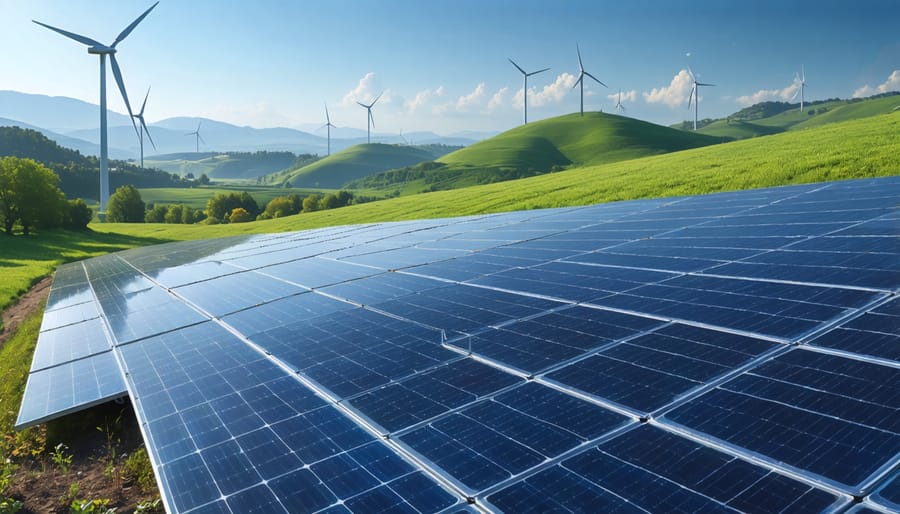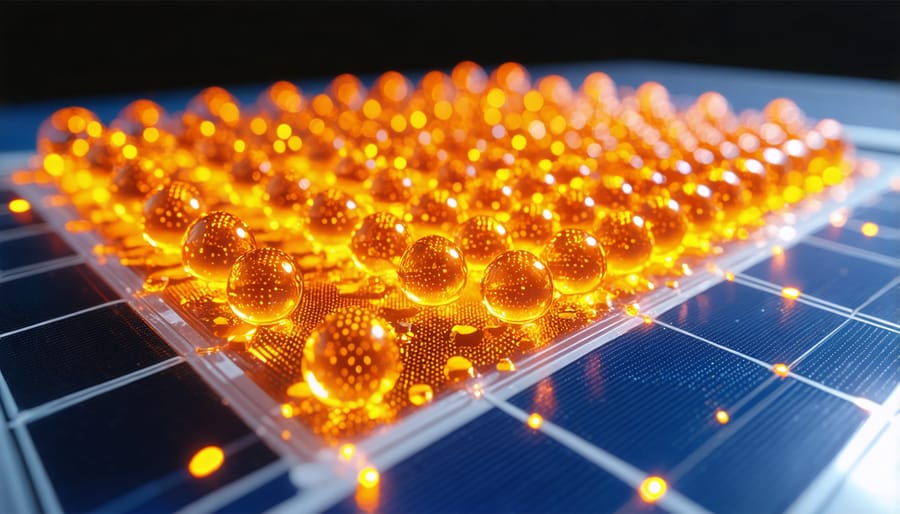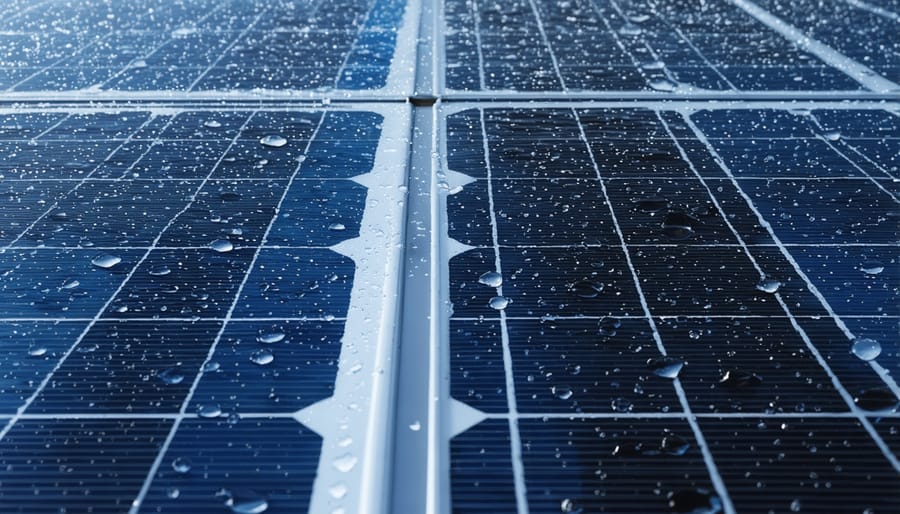Nano-Enhanced Solar Panels Are Revolutionizing European Energy Production

Nanotechnology is revolutionizing solar energy by manipulating materials at scales smaller than a human hair, pushing the boundaries of what’s possible in photovoltaic efficiency. Recent European innovations in nano-engineered solar cells have achieved conversion rates exceeding 29%, marking a significant leap from traditional panels’ 15-20% efficiency. These breakthrough technologies, including quantum dots and plasmonic nanostructures, are transforming how solar panels capture and convert sunlight into electricity.
As Europe accelerates its transition to renewable energy, nanotechnology offers a compelling solution to two critical challenges: maximizing energy generation in limited space and reducing production costs. Swedish and German researchers have developed nano-coatings that enhance light absorption while simultaneously reducing material usage by up to 30%, making solar technology more accessible and sustainable for both residential and industrial applications.
This convergence of nanotechnology and solar power represents more than incremental improvement—it’s a fundamental shift in renewable energy capabilities, promising to accelerate Europe’s path toward energy independence and climate goals.
How Nanotechnology Transforms Solar Panel Efficiency
Light-Trapping Nanostructures
Nanostructures are revolutionizing how solar panels capture and utilize sunlight. These microscopic surface patterns, engineered at the nanometer scale, create an intricate landscape that dramatically improves enhanced solar light capture. Think of these structures as tiny light traps that prevent photons from bouncing off the panel’s surface and escaping unused.
The most effective designs include pyramid-shaped nanostructures and wire arrays that create multiple opportunities for light absorption. When sunlight hits these features, it bounces between the structures several times, significantly increasing the probability of photon absorption. This process is particularly effective during morning and evening hours when traditional panels struggle with lower light conditions.
European researchers have developed specialized anti-reflective coatings incorporating these nanostructures, which can reduce surface reflection from 30% to less than 1%. This breakthrough means more photons are available for conversion into electricity, leading to higher energy output without increasing panel size or cost significantly.

Quantum Dot Enhancement
Quantum dots represent one of the most promising innovations in solar technology, offering remarkable potential for increasing solar panel efficiency. These nanoscale semiconductor particles, typically measuring between 2 and 10 nanometers, can be precisely tuned to capture specific wavelengths of light that traditional solar cells might miss.
What makes quantum dots particularly exciting is their ability to convert high-energy blue and ultraviolet light into multiple lower-energy electrons, a process known as multiple exciton generation. This characteristic allows solar panels to harvest more energy from the same amount of sunlight, potentially pushing conversion efficiencies beyond the theoretical limits of conventional solar cells.
European research institutions, including leading laboratories in Germany and Switzerland, have made significant breakthroughs in quantum dot technology. Recent developments have shown efficiency improvements of up to 25% in laboratory conditions. These nanoparticles can be integrated into existing solar panel manufacturing processes through cost-effective methods like spray coating or screen printing, making them an attractive option for upgrading solar technology without radical changes to production lines.

Latest Nano-Innovations in European Solar Manufacturing
Self-Cleaning Nanocoatings
One of the most innovative applications of nanotechnology in solar panels is the development of self-cleaning nanocoatings. These ultra-thin hydrophobic layers, typically just a few nanometres thick, help maintain optimal panel performance by preventing dust, dirt, and other contaminants from adhering to the surface.
The nanocoating works by creating a microscopic texture that mimics the natural self-cleaning properties found in lotus leaves. When water droplets fall on the treated surface, they form nearly perfect spheres that easily roll off, taking accumulated dirt particles with them. This process, known as the lotus effect, significantly reduces the need for manual cleaning and maintenance.
European research institutions have made significant advances in this technology, developing nanocoatings that can maintain their effectiveness for up to 10 years under normal weather conditions. Field tests in various European climates show that panels with these coatings maintain up to 98% of their original efficiency, compared to untreated panels which can lose up to 15% efficiency due to dirt accumulation.
The implementation of self-cleaning nanocoatings offers particular benefits in urban environments where air pollution and dust are common challenges. For homeowners and businesses, this translates to reduced maintenance costs and consistent energy production throughout the year, making solar installations more economically viable in the long term.

Perovskite-Silicon Tandem Cells
Perovskite-silicon tandem cells represent one of the most promising innovations in solar technology, combining traditional silicon cells with perovskite materials at the nanoscale. This hybrid approach enables panels to capture a broader spectrum of sunlight, significantly boosting their efficiency beyond what conventional silicon cells can achieve.
Recent developments in European research laboratories have demonstrated tandem cells reaching efficiency rates of up to 29.8%, compared to the typical 20-22% of standard silicon panels. The perovskite layer, engineered at nanoscale dimensions, converts high-energy blue and green light while allowing lower-energy light to pass through to the silicon layer beneath, maximising energy harvesting.
These advanced cells are particularly well-suited to European climate conditions, performing effectively even in diffused light and overcast conditions common across the continent. Manufacturers are working to scale up production while maintaining stability and durability, with several pilot projects already operational in countries like Germany and Switzerland.
The integration of nanoscale engineering in these tandem cells also addresses material sustainability concerns. The perovskite layer requires minimal material usage, potentially reducing production costs once scaled to commercial production. European research institutes and industrial partners are collaborating to overcome remaining challenges, such as long-term stability and manufacturing scalability, with promising results emerging from recent trials.
Practical Benefits for European Homes and Businesses
Enhanced Performance in Variable Weather
Nanotechnology is revolutionizing how solar panels perform in Europe’s diverse and often challenging weather conditions. Traditional solar panels typically experience significant efficiency drops during overcast days or when exposed to varying temperatures, but nano-enhanced panels are changing this dynamic.
By incorporating specialized nanostructures into the photovoltaic cells, these advanced panels can capture a broader spectrum of light, including diffused sunlight that’s common during cloudy European weather. This innovation means more consistent energy production, even in regions like Northern Europe where overcast conditions are frequent.
The nano-coating technology also provides superior temperature regulation. When conventional panels overheat during summer, their efficiency can drop by up to 25%. However, nanotech-enhanced panels maintain more stable temperatures through improved heat dissipation, resulting in consistently higher performance across seasonal temperature variations.
Furthermore, the hydrophobic properties of nano-coatings help panels stay cleaner for longer by preventing dust and dirt accumulation. This self-cleaning feature is particularly valuable in urban areas or regions with frequent rainfall, reducing maintenance needs while maintaining optimal performance.
Recent field tests across various European climate zones have shown that nano-enhanced panels maintain up to 90% of their peak efficiency even under suboptimal weather conditions, compared to 60-70% for traditional panels.
Long-Term Cost Benefits
Nanotechnology-enhanced solar panels deliver substantial solar investment benefits that extend well beyond the initial installation. While the upfront costs may be 15-20% higher than conventional panels, the enhanced efficiency typically leads to a return on investment within 4-6 years, compared to 7-9 years for traditional systems.
These nano-enhanced panels demonstrate remarkable durability, with performance warranties often extending to 25-30 years, significantly longer than standard panels. The improved resistance to environmental factors reduces maintenance costs by approximately 30% over the system’s lifetime. Additionally, their superior performance in low-light conditions increases annual energy generation by up to 25%, resulting in higher feed-in tariff revenues in European markets.
The economic advantages become particularly evident in large-scale installations, where the enhanced power output per square meter reduces the total installation area required, leading to savings in mounting hardware and installation costs. For European businesses, these panels often qualify for enhanced sustainability incentives and green energy certificates, further improving their financial viability. When factoring in rising energy costs and carbon pricing mechanisms, nano-enhanced solar panels represent a compelling long-term investment in sustainable energy generation.
Nanotechnology is revolutionizing solar energy in Europe, paving the way for a more sustainable and efficient energy future. Through innovative nanomaterials and advanced manufacturing techniques, solar panels are becoming increasingly efficient, durable, and cost-effective. These improvements are crucial for achieving the European Union’s ambitious renewable energy targets and accelerating the transition towards clean energy.
The integration of nanotechnology in solar panels represents more than just a technological advancement; it’s a fundamental shift in how we harness solar energy. With efficiency improvements of up to 40% in some applications, nano-enhanced solar panels are making renewable energy more accessible and economically viable for homeowners and businesses across Europe.
Looking ahead, ongoing research and development in nanotechnology promise even greater innovations. From self-cleaning surfaces to ultra-thin films that can be integrated into building materials, these advancements will continue to transform the solar energy landscape. As production scales up and costs decrease, nano-enhanced solar technology will play an increasingly vital role in Europe’s energy independence and sustainability goals, making clean energy more accessible while supporting the continent’s commitment to carbon neutrality by 2050.
Leave a Reply